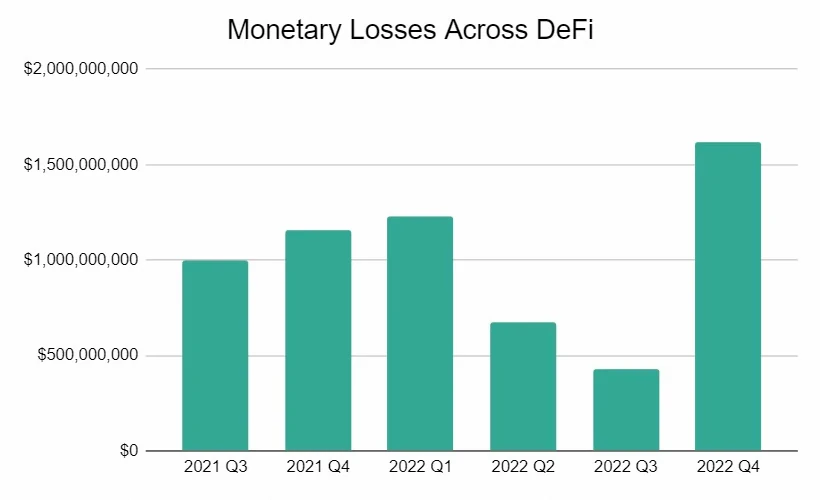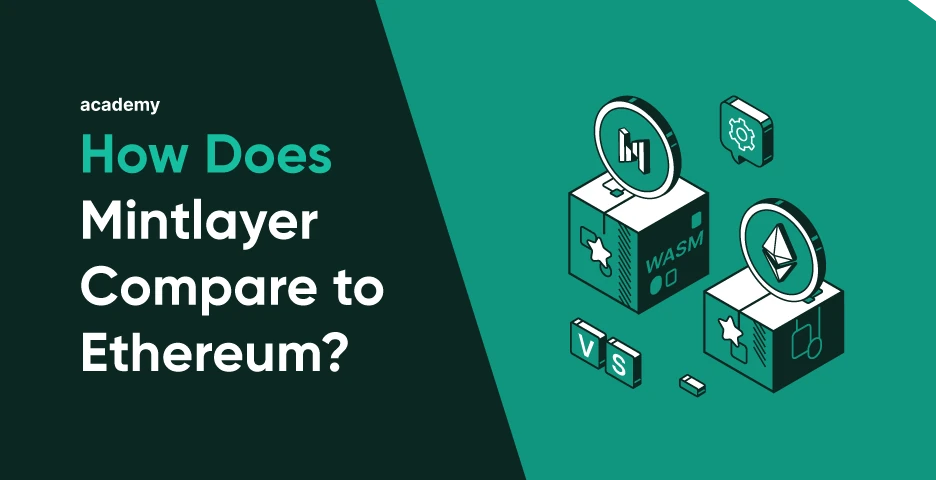Mintlayer and Ethereum have many similarities. They both allow users to create tokens, NFTs, and smart contracts. They both use a proof-of-stake mechanism for consensus. However, only one is directly interoperable with Bitcoin, and the key differences make Mintlayer and Ethereum two original projects with different audiences.
Bitcoin vs. Ethereum
Both Bitcoin and Ethereum are digital currencies that are recorded on a blockchain. They’re both stored in digital wallets, but the core products are very different.
In 2009, Satoshi Nakamoto created Bitcoin to be a digital version of gold or dollars. By solving the double spend problem, Bitcoin became the first secure and viable digital currency.
Vitalik Buterin created Ethereum with the more ambitious goal of replacing not only dollars but also the system that we build modern economies on. Ethereum’s smart contracts and primitive applications created an ecosystem known as “decentralized finance”.
Over the years, Ethereum has generated many impressive use cases and innovative projects, but the inherent security, the network effect, and the theoretical issues with Ethereum have allowed Bitcoin to maintain a market capitalization that’s almost twice as high.
These differences have resulted in a rift between users that prefer Bitcoin’s fundamental security and mission, and those that prefer Ethereum’s expanded capabilities.
Mintlayer reconciles that rift by using the proven technologies Bitcoin is built on and creating a DeFi platform that is fundamentally interoperable with them.
Mintlayer vs. Ethereum
We created Mintlayer as a project to bridge the gap between the DeFi capabilities of Ethereum and the existing user base of the Bitcoin community.
Beginning with the basic technology stack used to develop Mintlayer, there are many important differences. We designed Mintlayer from the ground up to be more accessible, secure, and efficient than existing DeFi protocols.
Consensus differences
Ethereum runs on a peer-to-peer network of nodes running the EVM (Ethereum Virtual Machine). The consensus and execution layers were separate networks before the merge. The new proof-of-stake consensus network, the Beacon Chain, has been running since December 2020.
In Mintlayer’s proof-of-stake mechanism, any user that stakes at least 0.01% of the total supply is eligible for selection as a full block participant. Participants that are selected will earn block rewards. Participants that cannot afford to stake the minimum block commitment can pool their ML tokens with others to meet the requirements of a full block participant.
Both blockchains use a proof-of-stake consensus mechanism, with different sources of generating randomness. Ethereum uses a RANDAO with the help of BLS signatures to contribute entropy, while Mintlayer uses a Verifiable Random Function (VRF). VRFs produce a proof that can be used by anyone to verify authenticity.
UTXO vs accounts
Mintlayer uses an unspent transaction output (UTXO) based accounting system (just like Bitcoin), while Ethereum is account based.
The easiest way to understand UTXOs is to think of it like cash, and think of an account based system like a debit card. If you have a wallet with a $5 bill, $10 bill, and $50 bill and you want to purchase a $6 cup of coffee, you can’t just send $6. You would give the store owner the $10 bill and receive $4 back. In the case of a UTXO, you would send a UTXO with $10 and receive a UTXO of $4 back, which is all recorded on the ledger.

In an account based system, the balances are recorded in a database and you can send a precise amount up to your total balance. It’s like a credit card in that parties recognize the validity of the credit, but it does not settle a transaction until all accounts in the system have been reconciled.
UTXO is ultimately more scalable. Since it is possible to process multiple UTXOs at the same time, it allows parallel transactions and encourages scalability innovation. It also offers a higher level of privacy since it is harder to link transactions.
Ethereum chose an account based system to make more complex transactions involving smart contracts easier to program at the time, and also based on the erroneous belief that smart contracts could not be programmed into Bitcoin because of UTXO transactions. Bitcoin script has allowed users to develop smart contracts on the BTC chain, and there are even applications for converting contracts written in solidity into contracts for sCrypt (the language used for Bitcoin SV).
The most important advantage to a UTXO based model is that it is easier to integrate with Bitcoin, the most popular and largest cryptocurrency network. Bitcoin has maintained a dominant market position since its inception; it has proven to be the most trusted digital currency. Mintlayer will integrate seamlessly with Bitcoin.
Mintlayer’s Fixed Total Supply
The total supply of Mintlayer’s ML token will be 600,000,000 tokens. 400,000,000 tokens will be created during the launch of the mainnet, and 200,000,000 will be available as staking rewards. Ethereum has no hard cap on its total supply.
There are a couple disadvantages to not capping the total supply. First, is that any currency that increases its supply will have more inflation. Developers attempt to program inflation with other variables, but it’s difficult to do when the supply keeps growing. Beginning users that wish for their tokens to maintain or grow in value relative to other tokens are sometimes deterred from participation when the total supply isn’t set.
Having no upper limit also benefits miners and blocksigners that have access to more computing resources. The advantage that larger organizations enjoy increases as new supply increases.
Why Not Bridge From BTC to ETH?
Existing blockchains use two primary methods to achieve interoperability; wrapped tokens, and token bridges.
A major disadvantage of wrapped tokens is that it depends on the security and trust of a third party to store the collateral token. There is currently no way for turing-incomplete assets like Bitcoin to be wrapped via a smart contract on the Ethereum blockchain. Instead, wrapping is done through a centralized program controlled by a third party (like wBTC).
wBTC’s marketcap is over $3 billion. All the value backing those tokens is centralized, and therefore much more susceptible to manipulation and loss.
Cross-chain bridge attacks were the leading cause of losses in DeFi in 2022. Bridges are soft targets for hackers because of their complexity and attack surface. Hackers have been able to use unsophisticated tactics such as social engineering and phishing to take control of hundreds of millions of dollars in assets.

For example, in the Ronin bridge exploit, hackers compromised five of the bridge’s nine validator nodes in a phishing attack. They drained $624 million, which wasn’t discovered for six days.
After investigating, authorities found that one organization controlled four of the validators, so it only took phishing two targets to access the entire depository.
Mintlayer addresses all three attack surfaces by removing the need for a token bridge or wrapped $BTC entirely.
With Mintlayer, users can use Bitcoin natively, removing the need for token bridges. The Mintlayer blockchain allows for a minimal friction route of tapping into the existing liquidity available in the Bitcoin ecosystem.
Ethereum will never be directly compatible with Bitcoin, which will require additional complex and vulnerable workarounds to bring liquidity over from the Bitcoin ecosystem.
MLS-02
We built Mintlayer from the ground up with servicing real world financial transactions in mind. One of our first unique products will be privacy tokens, MLS-02. MLS-02 tokens will allow for confidential transactions likely via ring signatures.
The normal transactions on Mintlayer offer a higher level of privacy by design through our UTXO model and the lightning network, but MLS-02 tokens will not only allow the fully confidential transaction of Mintlayer tokens but also confidential transactions for Bitcoin and other cryptocurrencies through a pegged MLS-02 token such as m-BTC or m-ETH.
EVM vs Wasm
One of the most important choices developers make when starting a new project is selecting the platforms they intend to build with, or creating their own proprietary platform.
Ethereum uses the Ethereum Virtual Machine (EVM), which is specifically designed for the Ethereum blockchain. It is a stack-based virtual machine that executes code written in Ethereum’s programming language, Solidity.
Mintlayer uses Wasm, a general-purpose virtual machine that can execute code written in any programming language that has been compiled to Wasm bytecode. Wasm was developed to execute code in web browsers efficiently, and is more flexible than EVM.
One key difference is that EVM is a stack-based machine, while Wasm is a register-based machine. This means that EVM uses a stack to store data and execute instructions, while Wasm uses registers to store data and execute instructions. This can impact the performance and efficiency of the two platforms, with Wasm being considered faster and more efficient than EVM.
EVM is also not as efficient as Wasm because it doesn’t support integers smaller than 256-bit; any 256-bit operation has to be performed by the CPU with multiple 64 or 32-bit operations.
Since Wasm can compile from a wider range of programming languages, a larger group of developers are qualified to work on projects using Wasm. There are also more robust tools available for development.
For these reasons, a switch to Wasm or a special hybrid called EWasm has been proposed and is in development for Ethereum.
Mintlayer has chosen Wasm because it’s not likely to be deprecated, the aforementioned performance advantages, and there is more support for development.
Lightning network
One of the biggest advantages Mintlayer enjoys is that the Lightning Network is already operational on the Bitcoin Blockchain. Our team has built Mintlayer with Lightning Network compatibility in mind from the beginning.
The Lightning Network is a Layer 2 solution grounded on the Bitcoin Blockchain. The protocol uses a peer-to-peer network to increase scalability and speed of transactions while simultaneously decreasing the cost.

By using Bitcoin’s ledger and its native smart contract language, each participant becomes a node to open bi-directional payment “channels”. Each channel will have a corresponding ledger entry on the Bitcoin blockchain.
Mintlayer is compatible with the Lightning Network in several ways. The Lightning Network is already integrated into the Mintlayer mobile wallet, and in the future, the Lightning Network will run as a layer 3 protocol on top of Mintlayer.
The Lightning Network can process 25 million transactions per second. Ethereum is doing 20 TPS, but developers hope that ETH 2.0 will handle 100,000 TPS in the future. Visa handles about 1,700 TPS, but claims their network could handle 24,000.
Ethereum’s Optimization Projects
There are several projects in development to increase the speed and throughput of Ethereum while decreasing transaction costs. The three most impactful projects are layer 2 protocols like Celer and Polygon, rollups (ZK and Optimistic), and sharding.
Layer 2 protocols and rollups will remove some of the transaction burden from the Ethereum blockchain, much like Mintlayer will do for Bitcoin. Layer 2 solutions on Ethereum are unproven.
Sharding is the process of splitting a database to spread the network load across more computers. Experts expect very basic integration of sharding to come online in the next two years that will help with data availability. Developers have found that they are a long way away from sharding the code execution part of Ethereum.
The primary benefit Ethereum will see from sharding is bringing more personal computers and mobile phones online for computational power. Mintlayer will ship with the capability of running a node on a personal computer or mobile phone.
The Lightning Network has been running for four years. Here, Bitcoin and Mintlayer’s optimization technology is not only superior, but is tested in real-world applications, while many Ethereum optimizations are still in development.
Conclusion
By leveraging open source solutions that have been proven to be more efficient, and avoiding paths that have proven to introduce unnecessary attack surface, Mintlayer solves many of the problems that other projects have introduced into DeFi.
Mintlayer truly stands on the shoulders of giants. The type of incremental improvement over existing projects that Mintlayer represents is the path toward a more equitable market for everyone.


